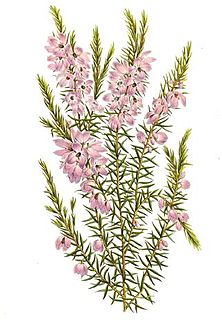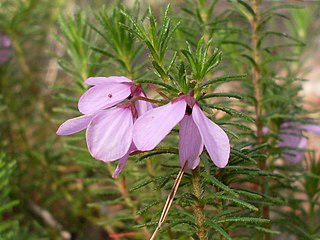
Tetratheca is a genus of around 50 to 60 species of shrubs endemic to Australia. It is classified in the botanical family Elaeocarpaceae, now known to encompass the family Tremandraceae, which the genus originally belonged to. It occurs throughout extratropical Australia, and has been recorded in every mainland state except the Northern Territory.

Telopea aspera, commonly known as Gibraltar Range waratah, is a plant in the family Proteaceae. It grows as a woody shrub to 3 metres (10 ft) high with leathery rough leaves and bright red flower heads known as inflorescences—each composed of hundreds of individual flowers. It is endemic to the New England region in New South Wales in Australia. It was formally described as a species by botanists Peter Weston and Mike Crisp in 1995, separated from its close relative Telopea speciosissima by its rough foliage and preference for dryer habitat. Unlike its better known relative, Telopea aspera has rarely been cultivated.

Persoonia acuminata is a plant in the family Proteaceae and is endemic to New South Wales. It is a spreading or prostrate shrub with relatively small leaves and cylindrical yellow flowers arranged singly or in groups of up to sixteen in leaf axils or on the ends of the branches. It grows in moist forest on the higher parts of the tablelands.

Persoonia rufa is a species of flowering plant in the family Proteaceae and is endemic to the a restricted area of New South Wales. It is an erect to spreading shrub with hairy young branchlets, elliptic leaves, and yellow flowers borne in groups of up to twelve on a rachis up to 110 mm (4.3 in), each flower with a leaf at its base.

Persoonia filiformis is a species of flowering plant in the family Proteaceae and is endemic to the south-west of Western Australia. It is a small, erect shrub with hairy young branchlets, linear leaves and greenish yellow flowers borne singly or in groups of up to twenty on a rachis up to 30 mm (1.2 in) long.

Tetratheca pilosa is a flowering plant in the family Elaeocarpaceae, endemic to Australia. It is a small shrub found in dry sclerophyll forests, open heathlands and woodlands of Australia. It was first recorded in 1805 by French botanist Jacques Labillardière.

Grevillea hortiorum is a species of plant in the protea family that is endemic to Australia.
Tetratheca paynterae, also known as Paynter's Tetratheca, is a species of plant in the quandong family that is endemic to Australia. There are two recognised subspecies.
Tetratheca similis is a species of plant in the quandong family that is endemic to Australia.
Tetratheca retrorsa is a species of plant in the quandong family that is endemic to Australia.
Tetratheca remota is a species of plant in the quandong family that is endemic to Australia.
Tetratheca paucifolia is a species of plant in the quandong family that is endemic to Australia.
Tetratheca parvifolia is a species of plant in the quandong family that is endemic to Australia.
Tetratheca fasciculata, also known as Cronin's Tetratheca, is an extinct species of plant in the quandong family that was endemic to Australia.
Tetratheca decora, also known as black-eyed susan, is a species of plant in the quandong family that is endemic to Australia.
Tetratheca rupicola is a species of plant in the quandong family that is endemic to Australia.

Tetratheca neglecta is a species of plant in the quandong family that is endemic to Australia.
Tetratheca labillardierei is a species of plant in the quandong family that is endemic to Australia.
Tetratheca insularis is a species of plant in the quandong family that is endemic to Australia.
Tetratheca harperi, also known as Jackson Tetratheca, is a species of flowering plant in the quandong family that is endemic to Australia.








